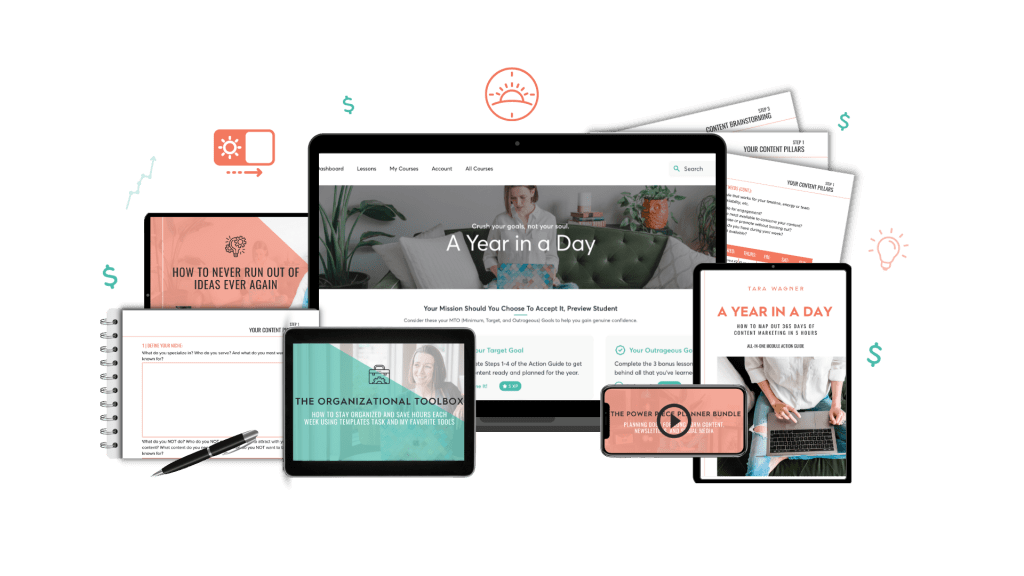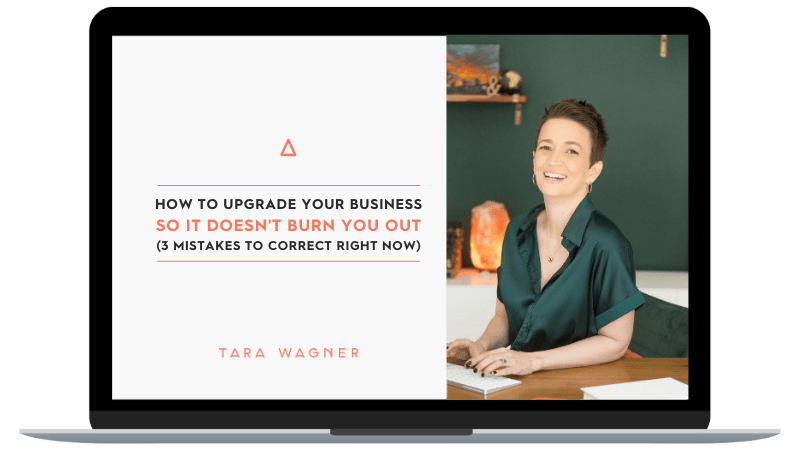So our last few Money Mindset blogs, we’ve talked a lot about pricing. Then I got the question of, if you realize you’re undercharging, how do you raise your prices without upsetting your customers? So that’s what I want to try to tackle in this blog.
Watch here or read on below.
Now, as we go through, I’m actually going to be using an example from Natalie Vaile.
She is a baker. Her company is Delicious UnVailed in Wisconsin. We talked a lot about her pricing and what she needs to do about it moving forward because she realized that she was undercharging. So what I’m going to do is try to share with you the strategies and the mindset, both that her and I spoke about, but also things that might apply to other businesses as well.
The goal here is to help you figure out exactly what you need to do to raise your prices, how you need to do it, and to help you do it in a confident way.
I want you to be able to do this right this time so that you’re not having to redo this in a couple of months because maybe you missed a couple things, or you did stuff that wasn’t really helpful, or maybe you didn’t even set your prices right the second time around, which is super normal. Don’t beat yourself up if it’s happened before. But definitely go through these strategies, and especially focus on the mindset so that how you do it is the most strategic and the most powerful way possible.
I want you to be able to do this right this time so that you’re not having to redo this in a couple of months because maybe you missed a couple things, or you did stuff that wasn’t really helpful, or maybe you didn’t even set your prices right the second time around, which is super normal. Don’t beat yourself up if it’s happened before. But definitely go through these strategies, and especially focus on the mindset so that how you do it is the most strategic and the most powerful way possible.
Okay, so again, Natalie’s a baker. She bakes things like cakes, cupcakes, cookies, and bars. And her question was:
“I’ve just started my business and already realized I’m not charging enough for my products. I don’t want to disappoint my customers by raising prices. There are other things that I make a good margin on, though. Should I keep things where they’re at currently and just try to push the products I actually make money on? “
Natalie Vaile

Step #1 – CULTIVATE THE RIGHT MINDSET
Now, the first thing that we get to tackle before we raise our prices here is mindset.
Because if we’re going into this with the mindset of worry, of fear, of I’m going to upset people, we’re going into it with the wrong mindset. We’re not going to actually solve the problem. We might create new problems, and it’s not going to actually create a successful business.
Belief to practice: Raising my prices is actually good for my clients or my customers as well.
Number one when it comes to mindset is to remember that you can’t continue to offer great products or great services if you can’t afford to stay in business.
Belief to practice: It is safe to charge more. And you can know that that’s true by the fact that other people are having success doing that same thing.
Next is to remember that others are likely charging what you need to charge because they have the same or similar overhead. They have the same budget. They also need to be able to make a living.
Belief to practice: Others want what I offer.
The next belief is that others want what I have to offer.
This especially came up with Natalie. Because when she set her prices, she set it based on what she knew that all of those baked goods were worth to her because she knew how much it costs. She knew how easy it was. She knew the time that went in to create it.
We tend to set pricing based on what we would pay for something. But you have to remember something, your customers/clients are not just paying for the product or service. They’re paying for the fact that they don’t have to do it themselves. You may not want to pay the pricing that you actually need to be charging because you’re skilled in what you do. So why would you pay for something that you can so easily do yourself?
Your target market is able or willing to pay what it is that you actually need to charge in order to stay in business.
This is because they’re paying for more than just the thing that you’re giving them. They’re paying for the ease, joy, the experience, and the fact that you just made their life a whole lot better.
Now, this is just an example of some of the mindsets that you need to adopt as you go into this. But, drop me a comment below if there are any other fears, any other worries on the back of your mind or any other mindset practices that might help you to be able to navigate this situation.

Step #2 – Do the math
The next step to do before you raise prices is to do the math.
And obviously you’ve done some of the math at least to know that you need to raise your prices, but I want you to really carefully go over the math you’ve done to make sure you’re not forgetting anything so that you don’t have to repeat this process in 6 months’ time.
So here are some things that I want you to make sure that you include in the math that you’re doing,
- How much you actually want to take home.
- What do you need to make to be able to actually make a profit and live a healthy lifestyle personally?
- Consider your tax burden
- Savings
- Health insurance needs (especially if you’re going to be self-employed)
All of these things now are coming out of your pocket, including your retirement.
Then, you’ve got things like:
- Overhead
- Supplies
- Materials
- Licensing
- Sales tax
- Packaging
- Utilities
- Rent
- Upcoming expenses, for instance if you need to replace your computer in the next couple of years, your time to deliver things, but also the time that you’re going to spend on marketing, promoting and so on…
Once you’ve got those numbers, I want you to look at your prices for your individual products or services and break those things all down to figure out your actual price per hour.
- What’s your actual profit per hour?
- What are you actually earning when you account for all the expenses and all of the time that’s going into not just delivering your product or creating your product, but marketing etc.?
Then I want you to reverse engineer this.
So you now know your actual cost and your actual profit per hour. Now I want you to play with your pricing to set 3 new prices. I want you to set a price based on the minimum profit that you want to make. Then a price set on the target profit, and a price set on the outrageous profit. I call these MTO goals, minimum, target, and outrageous.
Even if you’re not sure which price you’re going to land on, I want you to work on all three. This way you’ll see what’s actually possible and what those numbers will look like black and white on the paper.
Now, when Natalie did this, she realized that she didn’t have to raise her prices all that much in order to hit her minimum and her target profit. It was like 50 cents. So when you do this, you might also have a surprise in terms of what you can actually charge. Especially based on what your competitors might already be charging.
Step #3 – Analyze the numbers
The next step I want you to take to raise your prices is to really sit down and look at these numbers.
Analyze these numbers. Look to see, is there anything that I need to scale up? Is there anything that I need to scale back? Is there anything that I need to maybe potentially get rid of altogether because I’m just not going to be able to pull in the profit that I need to pull in to make this feasible? You might also look at, is there a different way that I can package things?
So in Natalie’s case, she was able to compare her cookies, which had a very low profit margin, to her cookie bars, which are actually much more popular and had a higher profit margin, and was able to see what products she might want to actually discontinue moving forward so she could double down on what was working and what was going to pay her bills.
Another example of repackaging was her ability to actually scale back on the size of her brownies. This increased the profit margin without actually changing too much of what the customer was receiving.
So, this is the trickiest part of this process, to really sit down and try to look at things with a fresh eye. And if it’s helpful, bring in somebody that you trust. Bring in a coach, bring in a friend that can help you reevaluate what you’re offering and really analyze those numbers with you to decide what’s going to be the best and most profitable moving forward.

Step #4 – ANALYZE YOUR TARGET MARKET
This is really important when it comes time to raise your prices, and most people don’t realize that it is, but you need to reevaluate your target market.
So when I was talking with Natalie, one thing that we discovered was that that a lot of her customers and clients that she was worried about upsetting were actually not her target market. When she looked at her target market, she wasn’t actually selling to those people like she wanted to be.
So ask yourself, “Who is my target market? And am I reaching them right now or do I need a new target market?”
And let me give you a hint here: If the people that you’re selling to can’t afford the actual price of something, the actual price being what it costs you to create it and to have a living based on it they’re not your target market. If you still want to serve them, you either need to find a new way to serve them or you need to find a new target market to serve.
Step #5 – Assess Any Damage
The next thing I want you to do is assess the actual damage that would follow if you did raise your prices.
So what you’re doing with this is looking at your customers now and figuring out how many people are actually going to be impacted by this price. So for instance, in Natalie’s case we looked at: how many repeat customers do you have on a regular basis? And since her business was pretty new, there wasn’t a lot of repeat customers. So she was looking at maybe upsetting a handful of people versus dozens and dozens of people.
Now, that might not be the case for you, but I do want you to know for yourself:
- What’s the actual number of people that I may upset with this?
- What’s the actual number of customers that I might lose with this price change?
- Am I willing to lose them?
- Am I able to replace them with a new target market who can actually afford what I have to offer?
And that’s a really important question. Are you willing to lose the wrong people in order to create the time and the energy to find the right ones?
All right, so you’ve been cultivating the right mindset. You’ve done your numbers. You’ve assessed the damage. Now let’s look at HOW.

How do you actually go about increasing your prices in a way that’s not going to upset your customers?
There are 6 strategies to raising your prices, including mindset strategies to help you do this confidently. Let’s go through those one at a time.
Strategy #1 – Repackage Your Offers
The first strategy for raising your prices is to repackage your offers into something else entirely.
This way, your customers don’t feel like they’re getting a price increase. They feel like they’re getting a whole new product or service.
For example, if you’re a coach who has been offering an hourly price, put together a package that includes a certain number of sessions, but maybe also includes some other things that you’ve created one time that you can give to them over and over again without creating any additional time strain for yourself.
In Nicole’s case, she was actually able to come up with the idea of having new cupcakes with new icing flavors that would justify a higher price.
So, what have you already created that can be recreated or repackaged into something new that you can charge more for?
Strategy #2 – Baby Step Your Regulars
The next strategy is to baby step those regulars as you raise your prices.
If you found that there’s 5, 10, or 50 regular clients or customers who might really notice the price increase and you don’t want to shock them with it, you can slowly increase the price for them instead. You can give just those people a special discount when it comes to your new pricing structure. You can even grandfather them in and decide to keep them at the same pricing structure indefinitely.
But, this isn’t the right case for all people.
I would only do this if the work that you’re going to be doing for them isn’t going to overtake the work that you’re going to be doing for clients or customers at that new price structure. Or if you really love these people and you’re okay losing some money while providing products or services to them. If you don’t absolutely love these people and you’re not willing to take that pay cut for them, I wouldn’t actually recommend this strategy.
The other downside is that they may be sending referrals to you based on their prices or they may even be purchasing for other people so that they can get other people their discount.
So if you’re going to do this, at least make sure that you’re doing this for high integrity clients who understand that this is just for themselves, they understand your reasoning for increasing prices for other people, and they may be even understand that this is a temporary thing and that their prices will increase as well.
Strategy #3 – Make a “Limited Time” Offer
The next strategy to raise your prices is to create a limited time offer.
This is where you’re announcing a price increase is coming, but they’ll be getting the same price until that date. This creates a perception of more value to the customer. Now you are positioning it as a limited time discount vs. just a pricing increase.
When you’re just advertising that your prices are going up, all you’re doing is delivering bad news. Instead, you can say, “my prices are going up, but until then you get X, Y, or Z”. That way you’re delivering good news vs. bad news. This is why I actually don’t recommend that you advertise a rate increase as it happens. Only do this before it happens when you can deliver it with good news.
Never send an email out to your customers just to tell them something bad that they’re not going to want to hear.

These are the most popular strategies I’ve used or that I’ve seen used over my 20 years as an entrepreneur. But when we talk about strategies, we also need to talk about HOW we want to approach these strategies.
Strategy #4 – Choose Your Mindset
Like I explained this to Natalie, you want to choose your mindset like you choose a new pair of shoes; meaning carefully. Making sure that it’s just the right fit for what you’re actually wanting to accomplish.
Some questions you can use to help define what that mindset is for yourself:
- What do you want to believe instead of what you’re worrying about?
- Exactly how do you want to feel, especially going into these situations with customers or clients?
- How do you also just want to feel around raising your prices in general?
- How do you want to act, carry yourself, and so on?
- What would it look like? Really get specific here.
- What would all of these things look like in action?
- What would you say to introduce your pricing in different scenarios that doesn’t come across apologetically or defensively? (Which tends to be our tendency when we’re worrying about what other people will think.)
As you determine what you want to say, I want to encourage you to use humor with it.
Strategy #5 – Practice your mindset
Once you’ve defined these things, I then want you to practice them. Practice the wording, body language, and the things that are going to help you to feel confident in this situation. Confidence comes from experience. So basically, you’re creating experiences just through the practice of how you want to show up.
So if you’ve defined specific ways that you want to explain the price increase, practice those things so that you feel confident in them.
But a little tip with this one is to practice all of this at an exaggerated level. Because in real life, we’ll always be a couple of notches down and so it will come across at the right energy.

Strategy #6 – PRACTICE HANDLING FEEDBACK
Lastly, we need to talk about how to handle any negative feedback when you might get when you raise your prices, gracefully.
The most important thing you can do here is just validate their emotions or their perception or experience of this. How they’re feeling about it has more to say about what they’re dealing with and less to do with you. Do not try to justify raising your prices. Do not apologize for raising your prices. It’s okay to make a profit in your business. In fact, it’s kind of preferred that you do. So, there’s actually nothing to apologize for here.
However, there is one time where an apology might actually be useful. You might actually want to apologize for not setting your prices appropriately in the first place.
This allows you to take some responsibility. It allows them to see that you’re taking responsibility without actually apologizing for having higher prices. Instead, just apologizing that they’ve had to go through the inconvenience of adjusting to those prices.
And here’s an example of how that might sound: “I really understand where you’re coming from. I apologize I didn’t set my prices where they needed to be to start with. But I really want to continue to provide a great experience for you. And I know I’ll be able to do that best when I can afford to stay in business.”.
What about you, boss lady?
I’d love to hear from YOU! If you are on the fence about whether or not you should raise your prices, what has been holding you back? Also, if you HAVE raised your prices, what made the transition most successful?





